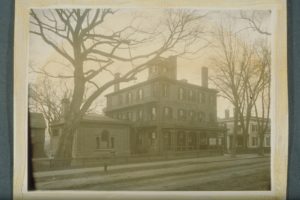By Elizabeth Correia
Addie Brown and Rebecca Primus were two free Black women whose lives intersected in Hartford, Connecticut. Brown was an orphan and supported herself by working as a domestic servant in Connecticut and New York. Primus was educated, taught newly freed Blacks, and helped build a school in Maryland. About 150 letters written by Brown to Primus exist today in the Connecticut Museum of Culture and History’s collections and detail moments of pride, sadness, anger, and happiness between the two women. They also contain amorous language that modern readers feel implies their relationship was more than friendship.
Together in Hartford
Rebecca Primus was born in Hartford in 1836 to Holdridge Primus, a grocery clerk, and Mehitable Jacobs, a seamstress. Addie Brown came to the Primus household at 20 Wadsworth Street to work. The Primuses often had young Black men and women boarding with them until they found suitable employment elsewhere. Addie was born on December 21, 1841 and grew up in Philadelphia with her aunt after her father passed away and her mother remarried. By the time Addie moved out of the Primus house to work in Waterbury in 1859, she already cared deeply for Rebecca. Their early letters contain sentiments such as, “I never shall love any person as I do you” and “wishing that I was in your loving arms and you would be imprinting sweat [sic] kisses.”
By 1861 Addie Brown worked as a domestic servant for a Black family in New York City. She took on dressmaking and millinery work while also helping to care for nine children. Brown felt trapped there—writing about longing to be with Rebecca, begrudgingly considering suitors for the economic benefits of marriage, sometimes going for weeks without pay, and suffering from chronic headaches. All the while, she pondered the escape she could have if Rebecca was a man: “It seem[s] I can see you now casting those loving eyes at me if you was a man what would things come to.”
Separate Lives
While Addie was in New York, Rebecca Primus was living at home and likely teaching at a school held in the Talcott Street Congregational Church. In November 1865, the Hartford Freedmen’s Aid Society sent Primus to teach in Royal Oak, Maryland. Her classes (taught in a local church) typically had thirty students in day sessions and twelve in night and offered instruction in reading, writing, geography, and arithmetic. Eventually Primus took it upon herself to fundraise for the construction of a schoolhouse. At the time, Primus was aware of resistance to the Freedman’s Aid Society from whites in Royal Oak, who stoned and verbally abused her coworker. Undaunted, she successfully gathered funds for her school from residents of Royal Oak and Hartford. The school was completed in 1867. Primus taught in the new building for two years before the Hartford Freedmen’s Aid Society ceased operation in 1869. The school (named Primus Institute) remained in use until 1929.

Miss Porter’s School ca. 1890, where Addie Brown held her most steady job – Connecticut Historical Society
At the age of twenty-four Addie Brown finally returned to Hartford to work as a seamstress at George Smith’s Dye House. It was a desirable job for someone in her position because wages were above average. She then worked for a professor at Trinity College who paid $2.50 a week, substantially less than Smith. Determined to have better, she wrote, “I have come to a decision stand that people shall pay me for my work I dont [sic] care colored or White.” Brown began working at Miss Porter’s School in Farmington in 1867. Here she attended lectures, sports games, concerts, and dances, and freely used the library. Brown left her position at Miss Porter’s School once she married longtime suitor Joseph Tines in 1868. She lived as a wife and mother in Philadelphia for two years before she passed away at home on January 11, 1870. Addie always regretted not having enough time with Rebecca.
In Hartford, Rebecca became the assistant superintendent of Talcott Street Congregational’s Sunday School in 1871. She married Charles Thomas, whom she had boarded with in Royal Oak. After Charles’ death in 1891, Rebecca moved in with her mother, and later her sister at 115 Adelaide Street. She continued to contribute to her community as a Sunday School teacher and deaconess at Talcott Street Congregational. Primus passed away on February 21, 1932. The fact that she held onto Addie’s letters her entire life seems to imply that Rebecca cherished the love they shared all through the sixty-two years she lived without Addie.
Elizabeth Correia holds an MA degree in Public History from Central Connecticut State University and works in cultural resource management.









